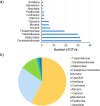Habitat-driven variation in mycorrhizal communities in the terrestrial orchid genus Dactylorhiza
- PMID: 27883008
- PMCID: PMC5121631
- DOI: 10.1038/srep37182
Habitat-driven variation in mycorrhizal communities in the terrestrial orchid genus Dactylorhiza
Abstract
Orchid species are critically dependent on mycorrhizal fungi for completion of their life cycle, particularly during the early stages of their development when nutritional resources are scarce. As such, orchid mycorrhizal fungi play an important role in the population dynamics, abundance, and spatial distribution of orchid species. However, less is known about the ecology and distribution of orchid mycorrhizal fungi. In this study, we used 454 amplicon pyrosequencing to investigate ecological and geographic variation in mycorrhizal associations in fourteen species of the orchid genus Dactylorhiza. More specifically, we tested the hypothesis that variation in orchid mycorrhizal communities resulted primarily from differences in habitat conditions where the species were growing. The results showed that all investigated Dactylorhiza species associated with a large number of fungal OTUs, the majority belonging to the Tulasnellaceae, Ceratobasidiaceae and Sebacinales. Mycorrhizal specificity was low, but significant variation in mycorrhizal community composition was observed between species inhabiting different ecological habitats. Although several fungi had a broad geographic distribution, Species Indicator Analysis revealed some fungi that were characteristic for specific habitats. Overall, these results indicate that orchid mycorrhizal fungi may have a broad geographic distribution, but that their occurrence is bounded by specific habitat conditions.
Figures



Similar articles
-
The Waiting Room Hypothesis revisited by orchids: were orchid mycorrhizal fungi recruited among root endophytes?Ann Bot. 2022 Feb 11;129(3):259-270. doi: 10.1093/aob/mcab134. Ann Bot. 2022. PMID: 34718377 Free PMC article. Review.
-
Variation in mycorrhizal associations with tulasnelloid fungi among populations of five Dactylorhiza species.PLoS One. 2012;7(8):e42212. doi: 10.1371/journal.pone.0042212. Epub 2012 Aug 3. PLoS One. 2012. PMID: 22870305 Free PMC article.
-
Mycorrhizal fungal community composition in seven orchid species inhabiting Song Mountain, Beijing, China.Sci China Life Sci. 2019 Jun;62(6):838-847. doi: 10.1007/s11427-018-9471-x. Epub 2019 Feb 22. Sci China Life Sci. 2019. PMID: 30810964
-
Low specificity and nested subset structure characterize mycorrhizal associations in five closely related species of the genus Orchis.Mol Ecol. 2010 Sep;19(18):4086-95. doi: 10.1111/j.1365-294X.2010.04785.x. Epub 2010 Aug 23. Mol Ecol. 2010. PMID: 20735736
-
Mycorrhizal fungi affect orchid distribution and population dynamics.New Phytol. 2018 Sep;219(4):1207-1215. doi: 10.1111/nph.15223. Epub 2018 May 23. New Phytol. 2018. PMID: 29790578 Review.
Cited by
-
Preventing Extinction of a Critically Endangered Dactylorhiza incarnata subsp. ochroleuca in Britain Using Symbiotic Seedlings for Reintroduction.Microorganisms. 2021 Jun 30;9(7):1421. doi: 10.3390/microorganisms9071421. Microorganisms. 2021. PMID: 34209355 Free PMC article.
-
Progress and Prospects of Mycorrhizal Fungal Diversity in Orchids.Front Plant Sci. 2021 May 7;12:646325. doi: 10.3389/fpls.2021.646325. eCollection 2021. Front Plant Sci. 2021. PMID: 34025694 Free PMC article. Review.
-
Mycorrhizal Fungal Partners Remain Constant during a Root Lifecycle of Pleione bulbocodioides (Orchidaceae).J Fungi (Basel). 2021 Nov 22;7(11):994. doi: 10.3390/jof7110994. J Fungi (Basel). 2021. PMID: 34829281 Free PMC article.
-
The Waiting Room Hypothesis revisited by orchids: were orchid mycorrhizal fungi recruited among root endophytes?Ann Bot. 2022 Feb 11;129(3):259-270. doi: 10.1093/aob/mcab134. Ann Bot. 2022. PMID: 34718377 Free PMC article. Review.
-
Mycorrhizal Associations and Trophic Modes in Coexisting Orchids: An Ecological Continuum between Auto- and Mixotrophy.Front Plant Sci. 2017 Aug 29;8:1497. doi: 10.3389/fpls.2017.01497. eCollection 2017. Front Plant Sci. 2017. PMID: 28912791 Free PMC article.
References
-
- Bernard N. Recherches experimentales sur les orchidées. Revue Gén. Bot. 16, 405–451 (1904).
-
- Burgeff H. Samenkeimung der Orchideen (Gustaf Fisher, Jena, 1936).
-
- McCormick M. K. & Jacquemyn H. What constrains the distribution of orchid populations? New Phytol. 202, 392–400 (2014).
-
- Jacquemyn H. et al.. A spatially explicit analysis of seedling recruitment in the terrestrial orchid Orchis purpurea. New Phytol. 176, 448–459 (2007). - PubMed
-
- Waud M., Wiegand T., Brys R., Lievens B. & Jacquemyn H. Nonrandom seedling establishment corresponds with distance dependent decline in mycorrhizal abundance in two terrestrial orchids. New Phytol. 211, 255–264 (2016). - PubMed
Publication types
MeSH terms
Substances
Grants and funding
LinkOut - more resources
Full Text Sources
Other Literature Sources
Research Materials

